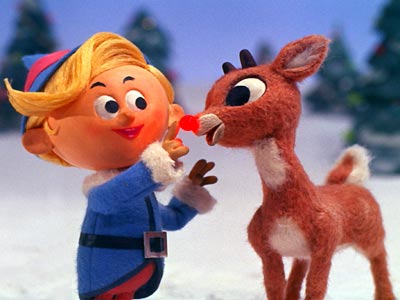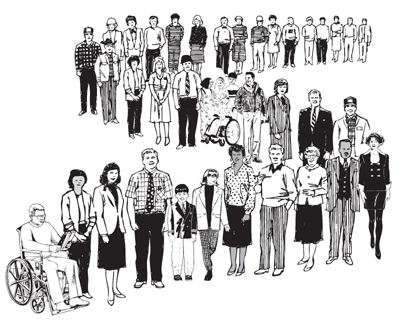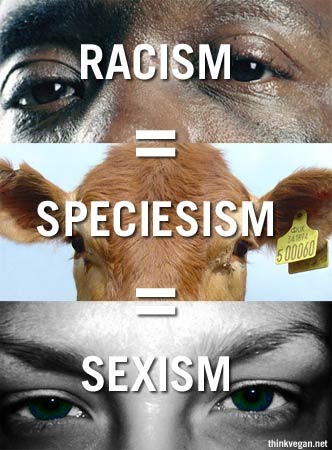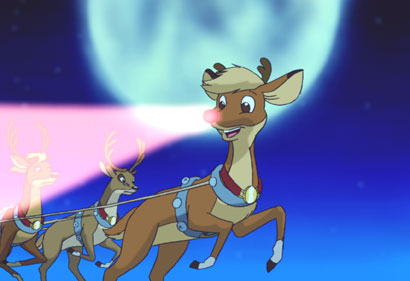
My apologies if this puts some coal in your stocking on Christmas Eve, but among the many wonderful tunes sung and played at Christmastime (the beautiful, transportive instrumental album Dulcimer Christmas comes highly recommended by yours truly), there is one that has never sat well with me: the story of Rudolph the Red-Nosed Reindeer. There have been various versions of it over the years — most notably the original 1939 booklet produced by Robert L. May for Montgomery Ward, and the 1964 stop-motion animation film (Snopes has a great overview of the history) — but if you recall, the most famous version of all is of course the 1949 Johnny Marks song, sung since by millions and millions of children.
The song leaves a lot of important questions unanswered, but what is there paints a pretty unsettling picture. Rudolph is a physically deformed young buck who is mocked and ostracized by his reindeer peers for looking different. They never let him join in any of their reindeer games; alack, poor Rudolph.
Eventually, it turns out that Rudolph’s deformity, a shiny red nose — so shiny, in fact, that one could even describe it as luminous — comes in handy (nosey?) during a particularly low-visibility Christmas Eve. Santa calls upon our snubbed protagonist, who, owing to his unique feature, is able to save the day. It is then (only then!) that all the reindeer love him.
I ask you, gentle reader: what kind of message is this sending to our children?
 Rudolph’s predicament of feeling different, excluded, and unable to fit in is something many kids must be able to relate to — and I think many parents assume the story has a positive message to tell them. But what are we to take away from the way Rudolph’s predicament is resolved?
Rudolph’s predicament of feeling different, excluded, and unable to fit in is something many kids must be able to relate to — and I think many parents assume the story has a positive message to tell them. But what are we to take away from the way Rudolph’s predicament is resolved?The conclusion to the story is ostensibly redemptive; but is it because the young reindeer come to empathize with the suffering they have inflicted on Rudolph, accepting him into society when they realize the inherent wrongness of their bigotry? No. At least in the song — I understand that the 1964 movie version tells the story quite differently — things only turn around for Rudolph when the thing that makes him abnormal happens to be also very valuable, and moreover, valuable in a way that is recognized as valuable by others.
Rudolph, in other words, becomes accepted because he is lucky. There is an optimistic way we can read the story: Rudolph’s shiny nose stands for the inner light that shines in each of us, through each of our unique and special attributes, waiting for the proper opportunity to finally become visible to others. Rudolph gains acceptance when his fellows realize not only that he is excellent in spite of being different, but excellent because of his difference. So, too, can each of us find ways to make the things that make us different become recognizable to others as displaying our unique worth. Perhaps there is even an excellence — a process of, in the parlance of our times, actualization or of finding the self — in learning how to make our unique worth recognizable to others.
 This question about the wisdom of the message of “Rudolph” points to a larger tension in our culture — one that was probably at its most apparent at the height of the P.C. era of the 1980s and 1990s, but that has been with us as long as we have been struggling to achieve civil rights and secure liberal democracy: are we supposed to rally around the motto that “everybody’s equal,” or is it that “everybody’s different”? Égalité or diversity? The former is very easily warped into the ludicrous and harmful “everybody’s the same” (a suggestion that has been brilliantly spoofed by Stephen Colbert’s repeated insistence that he literally “can’t see race”). And the latter is a notoriously tricky, somewhat fuzzy, and often challenged concept.
This question about the wisdom of the message of “Rudolph” points to a larger tension in our culture — one that was probably at its most apparent at the height of the P.C. era of the 1980s and 1990s, but that has been with us as long as we have been struggling to achieve civil rights and secure liberal democracy: are we supposed to rally around the motto that “everybody’s equal,” or is it that “everybody’s different”? Égalité or diversity? The former is very easily warped into the ludicrous and harmful “everybody’s the same” (a suggestion that has been brilliantly spoofed by Stephen Colbert’s repeated insistence that he literally “can’t see race”). And the latter is a notoriously tricky, somewhat fuzzy, and often challenged concept.One problem with the notion that “everybody’s the same” is that it papers over the great diversity of ways that people can be excellent and valuable. There is a potential wisdom in the message of “Rudolph” worth underlining: it teaches us that excellence often must be demonstrated in deeds. It celebrates that there are many ways we can be remarkable, and teaches us the virtue in striving to find them and show them. In other words, it tells kids that if they are different and don’t fit in, then they just need to find ways to prove everyone wrong by showing just how great they can be in their difference.
But the problem with this message is that many of the things that make us different from each other are not easily recognizable as great, particularly by the people we want to accept us. When the next mutant reindeer comes along, perhaps with a lump of coal for a nose instead of a light bulb, will the other reindeer have learned their lesson about acceptance and immediately let him join their reindeer games? I suspect that the coal-nosed reindeer too will have to struggle to show the specialness of his difference, and may well never find a way to fit in as well as Rudolph has.
For better or worse, the “Rudolph” song paints an honest picture of how equality and acceptance tends to be won in our own society. Black civil rights probably gained as much from the achievements of jazz, Ralph Ellison, Langston Hughes, and Jackie Robinson as from philosophical appeals to inherent human equality — as much, even, from the personages and deeds of Frederick Douglass and Martin Luther King, Jr., who were making those philosophical appeals, as from their words.
Of course, the notions of diversity and equality are bound up with one another. Our acceptance of people’s differences is tied to our expansion of equality — the realization that a person who is different from us is still equally a human being, and equally deserving of the rights and respect accorded to human beings. We still, that is, believe that equality comes not from what a person can do but from what he or she is.
And this is where the transhumanists come in. Transhumanists call for the proliferation of new posthuman forms; they celebrate diversity and tolerance; and they seek to smash such “-isms” as “speciesism,” acting, as we have noted, as if they are in fact the modern successors to the civil rights movement. But in avowedly rejecting the human, the transhumanists also reject, at least implicitly, our underlying human equality. And once we refuse to recognize our underlying equality, as poor Rudolph discovered, the best way we have left to get at what we are is through what we do.
Yet there are many people who already cannot do as much as most — the very young, the very old, the sick, and the disabled — who thus cannot easily demonstrate their worth in deeds. Consequently, philosophers like Peter Singer already declare that many of these groups should not be treated or defended as people at all. (It is not an accident or a quirky footnote of utilitarian belief that Singer defends killing infants and Alzheimer’s patients — including perhaps even his own mother.) And transhumanists, for all of their self-congratulatory tolerance, are either indifferent to or repulsed by these groups. (Or perhaps, charitably, they are repulsed for them, on their behalf.)
If these obviously human groups are already having trouble being recognized as people, how will they — and the rest of us — fare in the posthuman age? For while Rudolph was lucky to have his difference make him excellent in a way that was recognizable to others, the posthuman age will be defined by the dissolution of any shared notions of who we are and what is valuable about us. One of the new sorts of beings may be great in some way that is totally unrecognizable to the many other new sorts of beings. It may no longer be just the weakest human beings who will have trouble making the case for their worth in a way that others will understand.
“Rights,” “equality,” and “tolerance” may well lose their meaning in such a world. If that happens, you’d better make sure your bright-red nose can shoot lasers beams too.
[Images: The 1964 stop-motion film; diversity according to Fairfax County; Frederick Douglass; “speciesism” according to Flickr user thinkvegan; the 1998 animated film.]

Futurisms
December 24, 2010



The most obvious cases of people being declared to be unpersons in our society are aborted fetuses. In these cases, the justification is usually along the lines of "just because I feel like it." Insisting on something objective may save lives.
BTW, the something objective in the case of Down Syndrome victims may be here (in contrast to what some people think).